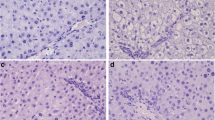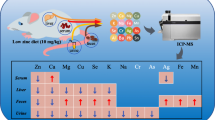Abstract
The aim of the present study was to compare the levels of essential trace and toxic elements in biological samples (blood and serum) of male liver cirrhotic/cancer patients (n = 144), of age groups 30–50 years, before and after 60 days treatment with mineral supplementation. For comparison purposes, the same biological samples were also collected from healthy male subjects (n = 120) of the same age groups. The biological samples were oxidized by 65 % HNO3/30 % H2O2 (2:1) in a microwave oven. The digests of all biological samples were analyzed for arsenic (As), cadmium (Cd), selenium (Se), and zinc (Zn) by electrothermal atomic absorption spectrometry. The levels of Se and Zn were lower in liver cirrhotic/cancer patients as compared to healthy individuals (p < 0.001). The patients with liver cirrhosis/cancer have twofold higher As and Cd levels in biological samples as compared to age-matched referents. Moreover, a negative correlation was observed between essential and toxic elements. The pathogenesis of liver cirrhosis/cancer has been associated with changes in the balance of certain essential trace and toxic elements. The study confirms that oral supplements of Se and Zn produce metabolic effects in patients with liver cirrhosis/cancer. It was observed that the status of essential trace elements, Se and Zn, was improved in biological samples of all patients after 60 days of treatment with mineral supplementation.




Similar content being viewed by others
References
Subramoniam A, Pushpangadan P (1999) Development of phytomedicines for liver diseases. Indian J Pharmacol 31:166–175
Bertoletti A, Gehring AJ (2006) The immune response during hepatitis B virus infection. J Gen Virol 87:1439–1449
Alberti A, Chemello L, Benvegnu L (1999) Natural history of hepatitis C. J Hepatol 31:17–24
Lok AS, McMahon BJ (2001) Chronic hepatitis B. Hepatology 34:1225–1241
Poynard T, Mathurin P, Lai CL et al (2003) A comparison of fibrosis progression in chronic liver diseases. J Hepatol 38:257–265
Kaczynski J, Hansson G, Wallerstedt S (2005) Clinical features in hepatocellular carcinoma and the impact of autopsy on diagnosis. A study of 530 cases from a low-endemicity area. Hepato-gastroenterol 52:1798–1802
Kubicka S, Rudolph KL, Hanke M, Tietze MK, Tillmann HL, Trautwein C, Manns M (2000) Hepatocellular carcinoma in Germany: a retrospective epidemiological from a low-endemic area. Liver 20:312–318
Hellerbrand C, Hartmann A, Richter G, Knoll A, Wiest R, Scholmerich J, Lock G (2001) Hepatocellular carcinoma in southern Germany: epidemiological and clinicopathological characteristics and risk factors. Dig Dis 19:345–351
Ghaedi M, Niknam K, Taheri K, Hossainian H, Soylak M (2010) Flame atomic absorption spectrometric determination of copper, zinc and manganese after solid-phase extraction using 2,6-dichlorophenyl-3,3-bis(indolyl)methane loaded on Amberlite XAD-16. Food Chem Toxicol 48(3):891–897
Karimipour G, Ghaedi M, Sahraei R, Daneshfar A, Biyareh MN (2012) Modification of gold nanoparticle loaded on activated carbon with bis(4-methoxysalicylaldehyde)-1,2-phenylenediamine as new sorbent for enrichment of some metal ions. Biol Trace Elem Res 145(1):109–117
Goldhabe SB (2003) Trace element risk assessment: essentiality vs. toxicity. Regul Toxicol Pharmacol 38:232–242
Prasad AS, Bao B, Beck FW, Kucuk O, Sarkar FH (2004) Antioxidant effect of zinc in humans. Free Radic Biol Med 37:1182–1190
Powell SR (2000) The antioxidant properties of zinc. J Nutr 130:1447–1454
Andrews GK (2001) Cellular zinc sensors: MTF-1 regulation of gene expression. Biometals 14:223–237
Maret W (2003) Cellular zinc and redox states converge in the metallothionein/thionein pair. J Nutr 133:1460–1462
Al-Bader AH, Hussain T, Al-Moosawi M, Mathew TC, Dashti H (1998) Selenium and liver cirrhosis. Mol Cell Biochem 185:1–6
Yu SY, Zhu YJ, Li WG (1997) Protective role of selenium against hepatitis B virus and primary liver cancer in Qidong. Biol Trace Elem Res 56:117–124
Blessing H, Kraus S, Heindl P, Bal W, Hartwig A (2004) Interaction of selenium compounds with zinc finger proteins involved in DNA repair. Eur J Biochem 271:3190–3199
IARC (International Agency for Research on Cancer) (2004) Tobacco smoke and involuntary smoking. IARC monographs on the evaluation of the carcinogenic risk OF chemicals to humans. IARC, Lyon, pp 1005–1178
Liu J, Waalkes MP (2008) Liver is a target of arsenic carcinogenesis. Toxicol Sci 105:24–32
Mazumder DN (2005) Effect of chronic intake of arsenic-contaminated water on liver. Toxicol Appl Pharmacol 206:169–175
Liu J, Zheng B, Aposhian HV, Zhou Y, Cheng ML, Zhang AH, Waalkes MP (2002) Chronic arsenic poisoning from burning high-arsenic-containing coal in Guizhou, China. Environ Health Perspect 110:119–122
Chen CL, Hsu LI, Chiou HY, Hsueh YM, Chen SY, Wu MM, Chen CJ (2004) Ingested arsenic, cigarette smoking, and lung cancer risk: a follow-up study in arseniasis-endemic areas in Taiwan. JAMA 292:2984–2990
Ahmet S, Tuzen M (2009) Biosorption of As(III) and As(V) from aqueous solution by macrofungus (Inonotus hispidus) biomass: equilibrium and kinetic studies. J Hazard Mater 164:1372–1378
Centeno JA, Mullick FG, Martinez L, Page NP, Gibb H, Longfellow D, Thompson C, Ladich ER (2002) Pathology related to chronic arsenic exposure. Environ Health Perspect 110:883–886
Landsberger S, Wu D (1995) The impact of heavy metals from environmental tobacco smoke on indoor air quality as determined by Compton suppression neutron activation analysis. Sci Total Environ 173–174:323–337
Waalkes M (2000) Cadmium carcinogenesis in review. J Inorg Biochem 79:241–244
Filipic M, Fatur T, Vudrag M (2006) Molecular mechanisms of cadmium induced mutagenicity. Hum Exp Toxicol 25:67–77
Tim N, Michelle P, Janneke H, Roels HA, Hilde C, Lutgarde T, Vangronsveld J, Etienne VH, Jan AS (2006) Environmental exposure to cadmium and risk of cancer: a prospective population-based study. Lancet Oncol 7:119–126
Grimmer G, Dettbarn G, Seidel A, Jacob J (2000) Detection of carcinogenic aromatic amines in the urine of non-smokers. Sci Total Environ 247(1):81–90
Tanaka K, Tsuji I, Wakai K, Nagata C, Mizoue T, Inoue M, Tsugane S (2006) Cigarette smoking and liver cancer risk: an evaluation based on a systematic review of epidemiologic evidence among Japanese. Jpn J Clin Oncol 36(7):445–456
WHO (2002) Reducing risks, promoting healthy life. World Health Organization, Geneva
Pfeifer GP, Denissenko MF, Olivier M, Tretyakova N, Hecht SS, Hainaut P (2002) Tobacco smoke carcinogens, DNA damage and p53 mutations in smoking-associated cancers. Oncogene 21:7435–7451
Hecht SS (1999) Tobacco smoke carcinogens and lung cancer. J Natl Cancer Inst 91(14):1194–1210
Arain MB, Kazi TG, Jamali MK, Afridi HI, Jalbani N (2008) Total dissolved and bioavailable metals in water and sediment samples and their accumulation in Oreochromis mossambicus of polluted Manchar Lake. Chemosphere 70:1845–1856
Arian MB, Kazi TG, Jamali MK, Jalbani N, Afridi HI, Ansari R, Abbas G (2008) Hazardous impact of toxic metals on tobacco leaves grown in contaminated soil by ultrasonic assisted pseudo digestion; multivariate study. J Hazard Mat 155:216–224
Cornelis R, Heinzow B, Herber RFM et al (1995) Sample collection guidelines for trace elements in blood and urine. Pure Appl Chem 67:1575–1608
Kazi TG, Jalbani N, Kazi N, Jamali MK, Arain MB, Afridi HI, Kandhro GA, Pirzado Z (2008) Evaluation of toxic metals in blood and urine samples of chronic renal failure patients, before and after dialysis. Ren Fail 30:737–745
Afridi HI, Kazi TG, Kazi N, Kandhro GA, Baig JA, Shah AQ, Jamali MK, Arain MB (2011) Evaluation of essential trace and toxic elements in biological samples of normal and night blindness children of age groups (3–7) and (8–12) years. Biol Trace Elem Res 143:20–40
World Health Organization (1996) Trace elements in aminolevulinic aciddehydratase (ALAD) inhibition human nutrition and health. International Atomic and Reduction of Erythrocyte Protoporphyrin Energy Agency. WHO Library publication data. Levels in vitamin C in occupational lead exposure in Geneva. pp: 194–215, 256–259
Axelsson MD, Rodushkin I (2001) Multi-element analysis of body fluids by double-focusing ICP-MS. Transworld Res Netw Recent Res Devel Pure & Appl Chem 5:51–66
WHO Press Release (2001) Hepatitis C. Saudi Med J 22:185–187
Blackard JT, Shata MT, Shire NJ et al (2008) Acute hepatitis C virus infection: a chronic problem. Hepatology 47:321–331
Santantonio T, Sinisi E, Guastadisegni A et al (2003) Natural course of acute hepatitis C: a long-term prospective study. Dig Liver Dis 35:104–113
Ali SA, Donahue RMJ, Qureshi H et al (2009) Hepatitis B and hepatitis C in Pakistan: prevalence and risk factors. Int J Infect Dis 13:9–19
Perz JF, Armstrong GL, Farrington LA et al (2006) The contributions of hepatitis B virus and hepatitis C virus infections to cirrhosis and primary liver cancer worldwide. J Hepatol 45:529–553
Di Bisceglie AM, Lyra AC, Schwartz M et al (2003) Hepatitis C-related hepatocellular carcinoma in the United States: influence of ethnic status. Am J Gastroenterol 98:2060–2063
Meran LF, Sirmatel S, AHI M, Tarakcioglu (2004) Plasma copper and zinc levels in chronic viral hepatitis. Saudi Med J 25:1066–1069
Kalkan A, Bulut V, Avci S, Celik I, Bingol NK (2002) Trace elements in viral hepatitis. J Trace Elem Med Biol 16:227–230
Stamoulis I, Kouraklis G, Theocharis S (2007) Zinc and the liver: an active interaction review article. Dig Dis Sci 52:1595–1612
Thirunavukkarasu C, Sakthisekaran D (2003) Sodium selenite, dietary micronutrient, prevents the lymphocyte DNA damage induced by N-nitrosodiethylamine and phenobarbital promoted experimental hepatocarcinogenesis. J Cell Biochem 88(3):578–588
Morales KH, Ryan L, Kuo TL, Wu MM, Chen CJ (2000) Risk of internal cancers from arsenic in drinking water. Environ Health Perspect 108:655–661
Liu J, Chen H, Miller DS, Saavedra JE, Keefer LK, Johnson DR, Klaassen CD, Waalkes MP (2001) Overexpression of glutathione S-transferase II and multidrug resistance transport proteins is associated with acquired tolerance to inorganic arsenic. Mol Pharmacol 60:302–309
NRC (1999) Arsenic in the drinking water. National Research Council, National Academy, Washington
IARC (International Agency for Research on Cancer) (2004) Monographs on evaluation of carcinogenic risk to humans. Some drinking water disinfectants and contaminants, including arsenic. Vol. 84, p. 269–477. IARC, Lyon
Navarro-Alarcon M, Lopez-Gde la Serrana H, Perez-Valero V, Lopez-Martinez MC (2002) Selenium concentrations in serum of individuals with liver diseases (cirrhosis or hepatitis): relationship with some nutritional and biochemical markers. Sci Total Environ 291:135–141
Wadhwa SK, Kazi TG, Chandio AA, Afridi HI, Kolachi NF, Khan S, Kandhro GA, Nasreen S, Shah AQ, Baig JA (2011) Comparative study of liver cancer patients in arsenic exposed and non-exposed areas of Pakistan. Biol Trace Elem Res 144:86–96
Afridi HI, Kazi TG, Shah F, Sheikh HU, Kolachi NF (2011) Evaluation of arsenic, cadmium, lead, and nickel in biological samples (scalp hair, serum, blood, and urine) of Pakistani viral hepatitis (A–E) patients and controls. Clin Lab 57:847–857
Burk RF, Early DS, Hill KE (1998) Plasma selenium in patients with cirrhosis. Hepatology 27:794–798
Afridi HI, Kazi TG, Kazi N, Kandhro GA, Baig JA, Shah AQ, Jamali MK, Arain MB (2010) Evaluation of toxic elements in scalp hair samples of myocardial infarction patients at different stages as related to controls. Biol Trace Elem Res 134:1–12
Jihen EH, Imed M, Fatima H, Abdelhamid K (2009) Protective effects of selenium (Se) and zinc (Zn) on cadmium (Cd) toxicity in the liver of the rat: effects on the oxidative stress. Ecotoxicol Environ Saf 72:1559–1564
Zhang M, Song G, Minuk GY (1996) Effects of hepatic stimular substance, herbal medicine, selenium vitamin E, and ciprofloxacin on cirrhosis in the rat. Gastroenterology 110:1150–1155
Lin CC, Huang JF, Tsai LY, Huang YL (2006) Selenium, iron, copper, and zinc levels and copper to zinc ratios in serum of patients at different stages of viral hepatic diseases. Biol Trace Elem Res 109:15–23
Korpela H, Kumpulainen J, Luoma PV, Arranto AJ MD, Sotaniemi EA (1985) Decreased serum selenium in alcoholics as related to liver structure and function. Am J Clin Nutr 42:147–151
Acknowledgments
The authors thank the Higher Education Commission, Pakistan for providing financial support to the National Center of Excellence in Analytical Chemistry, Sindh University, Jamshoro, Pakistan, responsible for sponsoring this project.
Author information
Authors and Affiliations
Corresponding author
Rights and permissions
About this article
Cite this article
Kazi, T.G., Kolachi, N.F., Afridi, H.I. et al. Effects of Mineral Supplementation on Liver Cirrhotic/Cancer Male Patients. Biol Trace Elem Res 150, 81–90 (2012). https://doi.org/10.1007/s12011-012-9501-y
Received:
Accepted:
Published:
Issue Date:
DOI: https://doi.org/10.1007/s12011-012-9501-y




